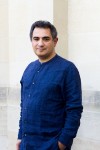A new donation has helped secure the future for UCLA’s Iranian music program.
The program will hold the first fund-supported event “Classical Persian Music: Hossein Omoumi, from Isfahan to Irvine” on Monday at Schoenberg Hall. It will feature a documentary screening and performances of classical Persian music.
The event came about as a result of a recent $60,000 donation from the Roshan Cultural Heritage Institute that will be used to sustain UCLA’s Iranian music program, said Amir Pourjavady, a director of the Persian Music Ensemble at UCLA. Mehrdad Arabifard, another director of the ensemble, said the new financial support for the Iranian music program will help generate further interest in Persian culture on campus by making Persian music classes more available to students.
“There’s a lot of interest to promote Persian music here,” Arabifard said. “(The) United States is a melting pot, and all the ethnicities come and contribute and … bring the community up.”
The Music of Persia Performance Group was one of UCLA’s first introductions to Iranian music and was established in the 1960s to help students learn how to perform classical Persian music. Students sang classical Persian tunes or played Persian instruments, such as the tombak, a type of percussion instrument, and the setar, a guitar-like instrument, before the ensemble disbanded in 1993 because of a lack of funding, Pourjavady said.
However, despite the ensemble’s 20-year hiatus, Steve Loza, the chair for the department of ethnomusicology, said student interest in the music genre has only grown. The program, which returned in 2016 and is now known as the Persian Music Ensemble, is overenrolled. Loza said he aims to allocate funding like the Roshan donation to support new classes and to open events like festivals and conferences.
“The best way to learn about a culture is really through its expressive modes,” Loza said.
Growing up, Arabifard said he was always surrounded by the kind of music he teaches today. His mother frequently sang at home and his brother was involved in music as a theater director. The first instrument he played was the tombak, which he learned taking classes at the Music of Preservation of Iran.
This quarter, Arabifard is teaching two classical Persian music courses, both of which focus primarily on the tombak. Although the tombak is a percussion instrument, he said classical Persian music is related to poetry in that many musical rhythms draw inspiration from poetic meter, so even percussion instruments like drums can be melodic.
In the ensemble, Arabifard teaches both the tombak and daf, another Persian percussion instrument. He said he also tries to teach his students to sing along with the instruments, so they can better understand the rhythm.
Unlike Arabifard, Pourjavady focuses more on string instruments, like the setar. He started out playing the setar before pursuing classical Persian music academically, he said. He also teaches singing and gives lectures on topics like the music of Iran at UCLA.
Since Persian music classes continue to be overenrolled, Loza said he hopes Monday’s presentation will provide a chance for students to learn more about Persian music and reflect students’ growing interest in the subject.
“It’s so important for students to see the value of musical culture in other cultures,” Loza said. “It’s a chance for students to learn about Persian culture through its rich musical tradition.”
